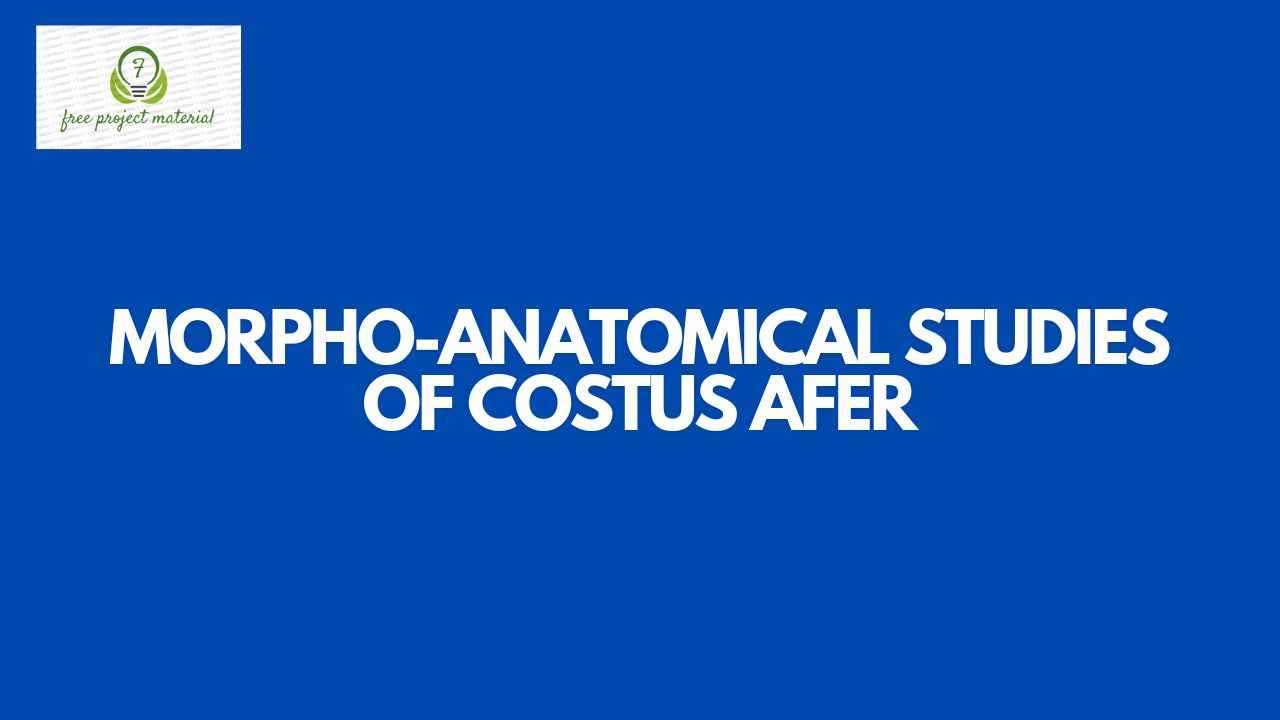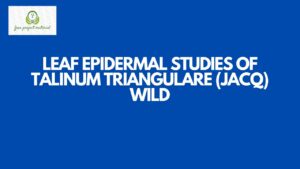ABSTRACT
A taxonomic study of Costus afar was conducted in search of useful and stable anatomical characters for the identification of the species. The quantitative microscopy of the leaf of Costus afar showed features of polygonal, straight, irregular, undulate, unicellular and anomocytic stomata. The epidermis is amphistomatic. The abaxial epidermal cell length, cell width, epidermal length and stomatal width was 53.55, 18.07, 25.48 and 17.43μm respectively, while the adaxial epidermal cell length, cell width, epidermal length and stomatal width was 44.84, 20.78, 37.19 and 22.10μm respectively. The specific standards obtained through experimentation are of important in the establishment of diagnostic features for the identification and preparation of monograph on the plant.
TABLE OF CONTENTS
Title page – – – – – – – – – i
Certification – – – – – – – – ii
Dedication – – – – – – – – – iii
Acknowledgements – – – – – – – iv
Abstract – – – – – – – – – v
Table of contents – – – – – – – – vi
CHAPTER ONE: INTRODUCTION
1.1 Background of the study – – – – – 1-3
1.2 Aim and objectives – – – – – – 4
1.3 Scope and Limitation – – – – – – 4
1.4 Definition of terms – – – – – – 5-6
CHAPTER TWO: LITERATURE REVIEW
2.1 Botanical Classification of Costus afar – – 7
2.2 Description of Costus afar – – – – – 8
2.3 Ecological distribution of Costus afar – – – 9
2.4 Phytochemical and nutrition of Costus afar – – – 10-11
2.5 Medicinal value of Costus afar – – – – 11-12
2.5.1 Analgesic and anti-inflammatory effect – – – 12-14
2.5.2 Anti parasitic and antidiabetic property – – – 15-16
2.5.3 Cross depressant activity – – – – – – 16-17
2.5.4 Protective ability against organs – – – – 17-19
2.6 Toxicology of Costus afar – – – – – 19-20
CHAPTER THREE: MATERIALS AND METHODS
3.1 Materials – – – – – – – – 21
3.2 Methods – – – – – – – – 22
3.2.1 Collection of Plant Sample – – – – 22
3.2.2 Anatomical Analysis of Costus afar – – – – 22-23
3.2.3 Statistical Analysis – – – – – – – 23
CHAPTER FOUR: RESULTS AND DISCUSSION
4 .1 Result – – – – – – – – 24-25
4.2 Discussion – – – – – – – – 29-30
CHAPTER FIVE: CONCLUSION AND RECOMMENDATION
5.1 Conclusion – – – – – – – –
5.2 Recommendation – – – – – – –
CHAPTER ONE
1.1 INTRODUCTION
The family costaceae consist of four general and approximately 200 species (Airy Shaw, 1973). The genus costus is the largest in the family with about 150 species that are mainly tropical in distribution (Humphries, 1985 and Hichey, 1981). In addition to its small size and distinctive morphology, costus has a pantropical distribution especially in the forest and savanna regions. Tomlinson, (1956) presented some reasons for treating the costaceae as a separate family based on a number of anatomical characters of the vegetative organs. Some of these diagnostic characters were summarized by Tomlinson, (1956). These include the uniseriate filamentous, hairs isodiametric, irregular, or transversely extended thin walled epiderial cells, tetracytic stomata (Stomata with subsidiary cells), slightly asymmetrical nature of guard cells, colours and continous hypodermis, clearly differentiated cortex, well developed vascular bundle at each nod restriction of silica to internal tissue close to vascular bundles, solitary bodies stellately spherical or drug like vessels restricted for root (Edeoga, 1991). Apart from preliminary investigation of Tomlison, (1956) on the anatomy of some members of costaceae no other information on custus igneus leaf, rhizome and root anatomy have been documented to the best of our knowledge. There has been an advancement in pharmacological discoveries over the years that has resulted in the production of many synthetic drugs. This therefore reiterates with worth of ethnomedicinal plants for drug discovery. Costus afar ker-Gawl (C. afar) with synonyms costus abliterans schum, costus anamocalyx schum, and costus insularis chev is a rhizomatous herb commonly know as ginger lily or “bush cane” (Thank God et al., 2014).
Almost every part of this plant is endowed with medicinal potential in disease such as malaria, measles diabetes mellitus, arthritis, and stomach disorders. In west Africa for instance the succulent stem is chewed to quench thirst and also to treat cough and its accompanying sore throat Omokhua and Taiwo, (2011). Various solvent extract of the plant leaves, stem rhizomes and roots have been studied and reported to contain chemical compounds that could be useful in the alleviation of oxidative stress- related conditions (Anyclsoe et al., 2010). A number of research studies have gone into finding bioactive compounds of plant origin with pharmacological properties to be used in the design of new drugs with lesser side effects. The several medicinal importance of C. afar makes it serves as one of the plants to attract this kind of research. However, information on its bioactivity safety profile, and active principles is scattered implicity, there is the need to collate these for easy accessibility that could enhance further research. In Nigeria traditional medicine has becomes a part of the people’s culture. The ministry of health in many African country including Nigeria now has a department or agency that oversees the affairs of traditional health care delivery system. In addition, formalized training of traditional health care attendants has started in many African countries.
1.2 Aim and Objective
1.2.1 Aim:- The aim of this research project is to determine the morpho-anatomical studies of Costus afar.
1.2.2 Objectives:- The objective of this research project is to
- Determine the morpho anatomical studies of Costus afar
- Compared the result of this analysis with the work of other researchers.
- To analyze the measured values of the features measured using statistical tools.
1.3 Scope and Limitation
The design of this research project is to investigate and determine morpho anatomical studies of Costus afar. Due to time, lack of adequate facilities and financial constraint, this research project is limited to morpho anatomical studies of Costus afar.
1.4 Definition of terms
Costus afar (C. afar): is a plant commonly known as ginger lily, spiral ginger or bush cane. It is reportedly used in traditional medicine practice (TMP) to treat and manage many ailments including diabetes mellitus, stomach ache, arthritis inflammation and gout.
Morpho-anatomical features: Morpho-anatomical aspects are features such as cuticle thickness, number of layers of palisade parenchyma, pubescence and leaf rugosity.
Ethnomedicine: Is a study or comparison of the traditional medicine based on bioactive compounds in plants and animals and practiced by various ethnic groups, especially those with little access to western medicines, e.g., indigenous peoples. Often these traditions constitute significant interactions with insects as well, in Africa, America, or around the globe. The word ethnomedicine is sometimes used as a synonym for traditional medicine

